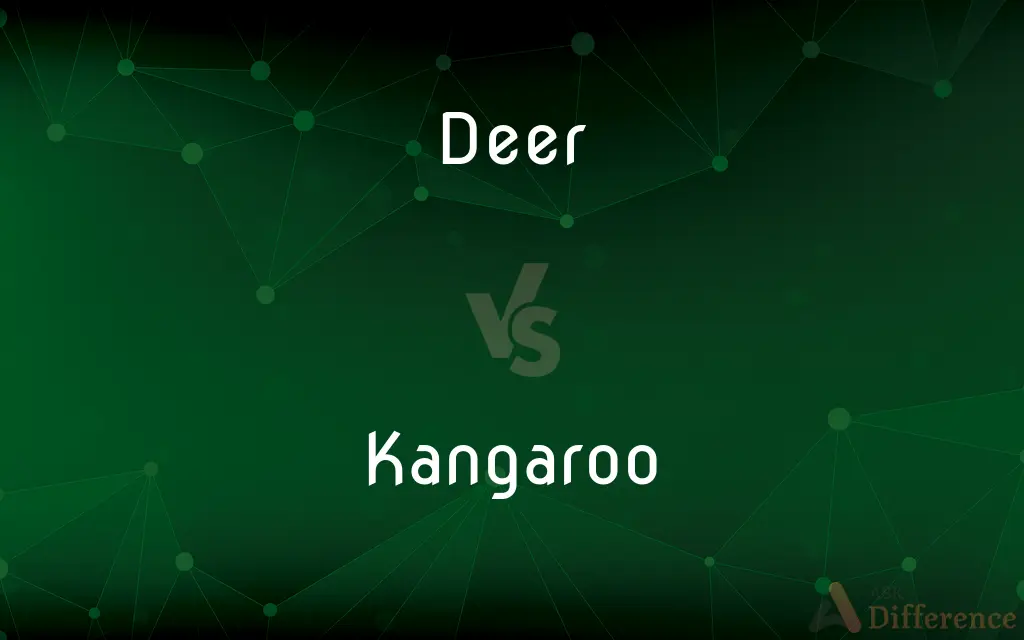Deer vs. Kangaroo — What's the Difference?
By Urooj Arif & Maham Liaqat — Updated on March 29, 2024
Deer are hoofed, antlered mammals primarily found in forests, while kangaroos are marsupials with powerful hind legs, native to Australia.

Difference Between Deer and Kangaroo
Table of Contents
ADVERTISEMENT
Key Differences
Deer are part of the Cervidae family, characterized by their antlers, which they shed and regrow annually. They are primarily forest-dwelling animals found in various environments worldwide. Deer are known for their graceful movements and can be both solitary and social, forming herds. Kangaroos, belonging to the family Macropodidae, are iconic for their large, powerful hind legs and tail, which they use for jumping and balancing. Native to Australia, kangaroos are marsupials, meaning they carry and nurse their young in a pouch. They are primarily grazing animals and live in groups called mobs.
While deer move through their environment by walking and running, with some species capable of swift and agile movements through dense forests, kangaroos are best known for their ability to leap great distances. This difference in locomotion reflects their adaptation to different habitats.
Deer are herbivores with diets consisting mostly of grass, leaves, and shoots. Their feeding habits vary depending on the species and the availability of food in their habitat. In contrast, kangaroos are also herbivores but are more specialized towards grazing, mainly eating grasses.
One significant reproductive difference is that deer give birth to live young, usually one or two fawns at a time, which are precocial and can stand and walk shortly after birth. Kangaroos give birth to underdeveloped young that crawl into the mother's pouch to continue developing, highlighting the marsupial reproduction strategy.
Comparison Chart
Classification
Mammals (Cervidae)
Marsupials (Macropodidae)
ADVERTISEMENT
Habitat
Forests, grasslands worldwide
Primarily Australia, various habitats
Locomotion
Walking, running
Leaping with powerful hind legs
Diet
Herbivore: grass, leaves, shoots
Herbivore: mainly grasses
Reproduction
Gives birth to live young, 1-2 fawns
Gives birth to underdeveloped young; uses pouch
Compare with Definitions
Deer
Forest-dwelling animals, part of the Cervidae family.
We spotted a deer through the trees at dusk.
Kangaroo
Animals that live in groups called mobs.
A mob of kangaroos rested in the shade during the hot day.
Deer
Herbivores known for their graceful movements.
The deer leapt away as we approached.
Kangaroo
Known for their unique method of locomotion – leaping.
The kangaroo used its tail for balance as it leaped.
Deer
Species that shed and regrow their antlers annually.
The male deer was growing a new set of antlers.
Kangaroo
Native Australian animals, known for their pouches.
The mother kangaroo carried her joey in her pouch.
Deer
Hoofed mammals with distinctive antlers.
The deer grazed quietly in the meadow.
Kangaroo
Herbivores that graze primarily on grasses.
Kangaroos were grazing near the campsite at dawn.
Deer
Animals that can be solitary or form herds.
A herd of deer crossed the path early in the morning.
Kangaroo
Large marsupials with powerful hind legs.
The kangaroo bounded across the field with ease.
Deer
Any animal; especially, a wild animal.
Mice and rats, and such small deer.
The camel, that great deer.
Kangaroo
(intransitive) To hunt kangaroo.
Deer
Deer or true deer are hoofed ruminant mammals forming the family Cervidae. The two main groups of deer are the Cervinae, including the muntjac, the elk (wapiti), the red deer, the fallow deer, and the chital; and the Capreolinae, including the reindeer (caribou), the roe deer, the mule deer, and the moose.
Kangaroo
The kangaroo is a marsupial from the family Macropodidae (macropods, meaning "large foot"). In common use the term is used to describe the largest species from this family, the red kangaroo, as well as the antilopine kangaroo, eastern grey kangaroo, and western grey kangaroo.
Deer
Any of various hoofed ruminant mammals of the family Cervidae, characteristically having deciduous antlers borne chiefly by the males. The deer family includes the white-tailed deer, elk, moose, and caribou.
Kangaroo
Any of various large herbivorous marsupials of the family Macropodidae of Australia and adjacent islands, having short forelimbs, large hind limbs used for leaping, and a long tapered tail.
Deer
A ruminant mammal with antlers and hooves of the family Cervidae, or one of several similar animals from related families of the order Artiodactyla.
Kangaroo
A member of the Macropodidae family of large marsupials with strong hind legs for hopping, native to Australia.
Deer
(in particular) One of the smaller animals of this family, distinguished from a moose or elk
I wrecked my car after a deer ran across the road.
Kangaroo
A hooded jacket with a front pocket, usually of fleece material, a kangaroo jacket.
Deer
The meat of such an animal; venison.
Oh, I've never had deer before.
Kangaroo
To practice kangaroo care on an infant; to hold a premature infant against the skin.
Deer
Any animal, especially a quadrupedal mammal as opposed to a bird, fish, etc.
Kangaroo
(intransitive) To move like a kangaroo.
Deer
A ruminant of the genus Cervus, of many species, and of related genera of the family Cervidæ. The males, and in some species the females, have solid antlers, often much branched, which are shed annually. Their flesh, for which they are hunted, is called venison.
Kangaroo
Of or relating to Australia.
Deer
Distinguished from Bovidae by the male's having solid deciduous antlers
Kangaroo
Characterized by rapidly jumping prices in securities markets or by belief that the prices are unstable in contrast to bear and bull markets.
Kangaroo
Any one of numerous species of jumping marsupials of the family Macropodidæ. They inhabit Australia, New Guinea, and adjacent islands, They have long and strong hind legs and a large tail, while the fore legs are comparatively short and feeble. The giant kangaroo (Macropus major) is the largest species, sometimes becoming twelve or fourteen feet in total length. The tree kangaroos, belonging to the genus Dendrolagus, live in trees; the rock kangaroos, of the genus Petrogale, inhabit rocky situations; and the brush kangaroos, of the genus Halmaturus, inhabit wooded districts. See Wallaby.
Kangaroo
Any of several herbivorous leaping marsupials of Australia and New Guinea having large powerful hind legs and a long thick tail
Common Curiosities
Are deer and kangaroos found in the same habitats?
No, deer are found worldwide in forests and grasslands, while kangaroos are native to Australia and occupy diverse habitats.
How do deer and kangaroos differ in movement?
Deer walk and run, using agility to navigate, while kangaroos are known for their distinctive leaping.
How do deer and kangaroos reproduce?
Deer give birth to live young that are relatively developed, while kangaroos give birth to underdeveloped young that continue to grow in a pouch.
Do all deer have antlers?
Generally, only male deer have antlers, which they shed and regrow annually.
Are there different species of deer and kangaroos?
Yes, there are numerous species of both deer and kangaroos, each adapted to specific environments.
What distinguishes a deer from a kangaroo?
A deer is a hoofed mammal with antlers, whereas a kangaroo is a marsupial with powerful hind legs for leaping.
How fast can kangaroos leap?
Kangaroos can reach speeds of up to 60 km/h (about 37 mph) when leaping.
Is the deer diet seasonal?
Yes, the deer diet can change with seasons, depending on the availability of food.
What do deer eat compared to kangaroos?
Both are herbivores, but deer have a broader diet including grass, leaves, and shoots, while kangaroos primarily graze on grasses.
Can both deer and kangaroos swim?
Yes, both animals are capable of swimming when necessary.
What role does the kangaroo's tail play?
The kangaroo's tail acts as a powerful stabilizer and support when leaping or standing.
Can deer and kangaroos be found in groups?
Yes, deer can form herds, and kangaroos live in groups known as mobs.
How do kangaroos carry their young?
Kangaroos carry their underdeveloped young in a pouch where they continue to develop after birth.
What is the significance of antlers for deer?
Antlers are used for defense, dominance disputes, and attracting mates.
How long do kangaroos stay in their mother's pouch?
Joeys typically stay in the pouch for about six months before gradually venturing out.
Share Your Discovery

Previous Comparison
Finding vs. Conclusion
Next Comparison
Mountain vs. FountainAuthor Spotlight
Written by
Urooj ArifUrooj is a skilled content writer at Ask Difference, known for her exceptional ability to simplify complex topics into engaging and informative content. With a passion for research and a flair for clear, concise writing, she consistently delivers articles that resonate with our diverse audience.
Co-written by
Maham Liaqat












































